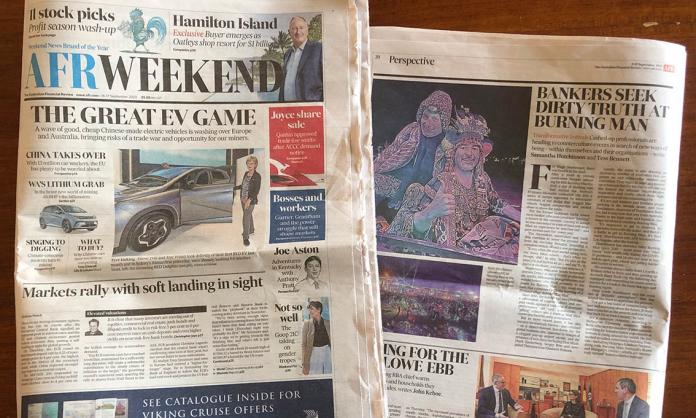The Australian Financial Review is written as if the paper’s editors expect few people outside the ranks of the Australian ruling class to read it. They’re probably right to assume so.
Flicking through its pages, there are innumerable signs that, if you’re not among the layer of people who would think nothing of dropping $10,000, on a whim, for business class flights to London, then it’s very much not for you. In the AFR, all holidays/cars/watches etc. are luxury, every property is high end, and all schools are private. To the extent that there are problems, they’re not just “first world” problems, but what we might call “first class” problems.
Want to know how investment bankers and construction company executives dealt with the torrential downpour at the recent Burning Man festival? That’s the kind of reporting you’ll find in the AFR (“there’s no ability to simply buy your way out of anything ... [and] that is half the experience”, one attendee told the paper before refusing, along with other interviewees, to “say how much they paid to get there and to be part of their camps”).
It’s clear from the AFR’s coverage that Australia’s rich-listers are very much enjoying the ever growing share of national wealth that’s flowing their way. Pick up an issue of the paper, and chances are you’ll find extensive coverage on topics like “Why everyone is off for a big Euro summer”, “Australia’s top bosses spend big on $65.6m of trophy homes”, and “Crisis, what crisis? Luxury boom shows staying power of ultra-rich”.
Perhaps the paper’s most rage-inducing feature is to run, alongside articles like these, extensive reports and analyses centred on ruling-class concerns about the various ways in which workers and/or governments might ruin their fun.
An article about the Victorian government’s housing policy provides a recent example. Headlined “Victoria’s housing shake-up risks dampening property price growth”, the article lamented, “Victoria’s plan to build 800,000 new homes over the next 10 years has the potential to flood some areas with housing supply that could dampen capital gains and investment returns over the long term”. The horror!
Along similar lines was an article published in June railing against the idea that governments might cut funding to private schools. To describe the author of that article, an AFR senior correspondent by the name of Aaron Patrick, as out of touch doesn’t quite capture it. In his topsy-turvy toffy world: “Liberal and Labor governments have poured money into government schools” because of their “envy and resentment towards the private systems’ successes”. (Never mind that per-student funding for private schools rose, between 2012 and 2021, at twice the rate of funding for public schools.)
According to Patrick, it would actually reinforce elitism if private school funding was cut, because that would mean fewer middle-class people could afford to send their kids to one. The reason it didn’t occur to him that another way to counter elitism would be to significantly boost funding to public schools becomes apparent towards the end of his piece. To the extent that the public system doesn’t perform as well, it’s not, as he sees it, about inadequate funding, but the fact that “non-selective state schools are more likely to tolerate mediocrity, in students and staff”.
Would it surprise you to learn that in 2021 Aaron Patrick was charged with animal cruelty for allegedly kicking a dog in the face? Me neither.
Another thing AFR writers have been worried about of late is the prospect of the dreaded “wage-price spiral”. The Fair Work Commission’s decision, announced in June, to award a (below inflation) 5.75 percent pay rise to minimum wage workers drew particular ire. In the lead-up to the decision, a flurry of articles highlighted the unanimous view among representatives of big business that the commission needed to “exercise restraint”. “An excessive increase in the minimum wage”, Australian Industry Group head Innes Willox told the paper, “would clearly risk further embedding inflation and setting off a wage-price spiral”.
In the aftermath of the decision, the paper’s coverage continued on the same lines, with headlines including “Minimum wage rise will push up prices, put jobs at risk: Gerry Harvey”, “‘You can’t charge $100 for pasta’: wage rise adds pain for businesses”, and “Wage rise locks in another interest rate increase”. You certainly wouldn’t guess, as a regular reader of the AFR, that the main driver of inflation—according to research by the OECD—is rising profits, not wages. Restraint is only for the plebs.
Seen in the light of all this, it’s hardly surprising that someone like property developer Tim Gurner would think nothing of using an AFR property summit as an opportunity to mouth off about the supposed “arrogance in the employment market”. Saying, as he did, that unemployment needs to rise by 40 to 50 percent and that “we need to see pain in the economy” to put workers in their place is just a blunter way of expressing what many of the paper’s contributors and the ruling-class figures whose views it regularly promotes have been saying all year.
As Gurner found out when the video of his remarks went viral, to those living outside the comfortable bubble inhabited by Australia’s wealthy elite, the idea that workers are the arrogant ones doesn’t really pass the pub test (or any other kind of test for that matter). The profits share of Australia’s GDP is at a record high, the wages share at a record low. The Australian ruling class has never had it so good, while workers are suffering the biggest fall in real wages in a generation.
This is a reality the AFR seems keen not to allow to disturb the delicate sensibilities of its affluent readership. It provides an intellectual “safe space” for the Tim Gurners of the world—the kind of people who see workers demanding a fairer share of society’s wealth as akin to a human rights abuse.









